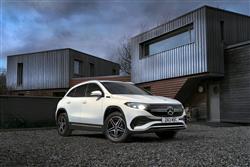Mercedes-Benz EQA - ABC Leasing
How will you view?
This is a sample, showing 30 seconds of each section.
MERCEDES ELECTRIFIES IT'S A GAME(some text hidden)
By Jonathan Crouch
Ten Second Review word count: 52
This is what the Mercedes of compact electric cars looks like. The EQA isn't the most sophisticated or longest-running small EV out there, but the Stuttgart maker is hoping that when it comes down to it, this will be the one that customers in search of a premium alternative would rather have.
Background word count: 162
Mercedes has long needed a relatively affordable all-electric family hatchback. BMW has its iX1. Audi has the Q4 e-tron, Volkswagen has the ID.3 and ID.4. Plus there's the Ford Mustang Mach-E, the Skoda Enyaq iV and the CUPRA Born. So Mercedes has pulled out all the stops to bring us this EQA. There wasn't time for the Stuttgart brand to construct a bespoke electric platform for this model of the kind that features on its competitors. So it must sit on the same MFA underpinnings as the compact GLA crossover it's based upon, a chassis not originally designed for full electrification. Quite a lot of work's had to go in then, to revise this platform to take the weight of this EQA's 66kWh drive battery. The pay-off though for Mercedes is that it means that this BEV can roll down the same German Rastatt production line as its GLA combustion engine counterparts. Let's take a look at what this car can offer.
Driving Experience word count: 343
Setting off in this Mercedes feels all very normal. There's the same kind of starter button and column-mounted auto gear lever that you'd find in any normal combustion engine model in the Stuttgart maker's range. Mainstream versions of the EQA are based around a single powertrain and battery package, dubbed the 'EQA 250+'. Here, a 70.5kWh battery pack and a single asynchronous electric motor sit on the front axle and produce a combined output of 188bhp and 375Nm of torque. Drive is through the usual fixed-ratio auto gearbox common to full-battery models. Like all EVs, the EQA shoots away from rest like a scalded cat as all the torque is developed all at once. And, like all EVs, it runs out of puff a little once the 62mph mark is passed (in 8.9s), eventually topping out at just 99mph. If you want to go faster in an EQA, you'll need to talk to your dealer about the two 4MATIC models, the EQA 300 (with 228hp) and the EQA 350 (with 292hp), the latter capable of 0-62mph in around 6 seconds. These still use the older 66.5kWh battery. Our focus here though, is on the volume EQA 250 derivative and the stat you'll be most interested in with that particular variant is driving range, rated at up to 324 miles from a single charge (the 4MATIC models deliver a max of 268 miles). That's not particularly noteworthy; to give you some segment perspective, a rival Volkswagen ID.3 with a 77kWh battery manages up to 341 miles. Expect longer range EQAs in the future. To maximise the range you do have, you'll need to make proactive use of the various brake regenerative energy harvesting modes on offer. The most aggressive setting is 'D - -', in which you feel sharp retardation whenever you come off the throttle. That's useful in town, meaning you hardly ever need to use the brakes, except when coming to a complete stop. The least aggressive setting is 'D+', in which the car coasts without any perceptible off-throttle braking, maintaining momentum.
Pictures (High res disabled)

.jpg)
.jpg)
.jpg)
.jpg)
.jpg)
.jpg)
.jpg)

Scoring
Category: Compact Car
| Performance | |
| Handling | |
| Comfort | |
| Space | |
| Styling | |
| Build | |
| Value | |
| Equipment | |
| Economy | 50% |
| Depreciation | 80% |
| Insurance | 70% |
| Total | 68% |